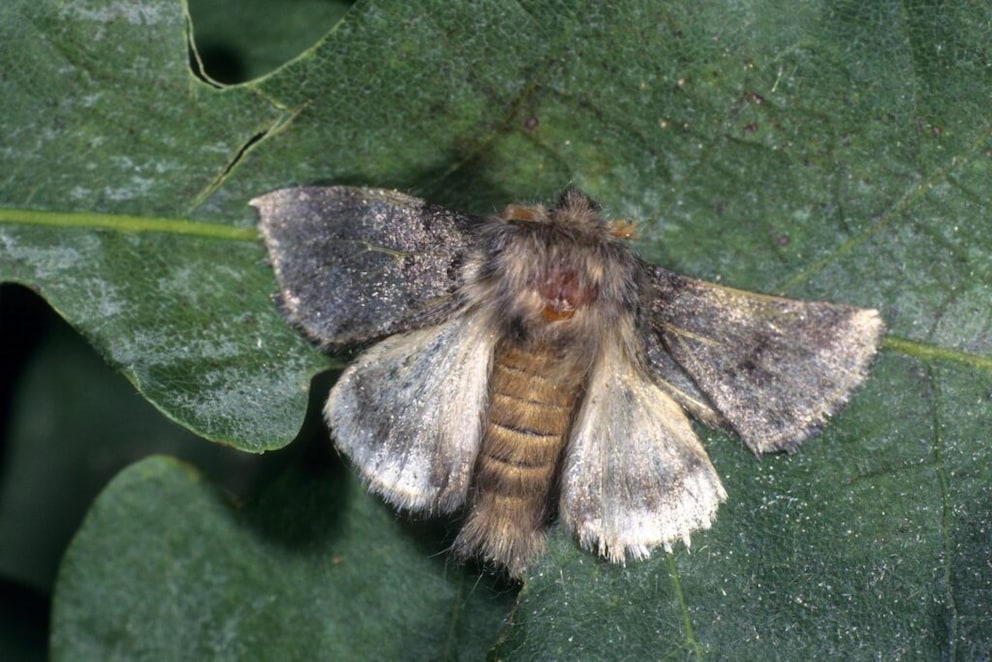June 11, 2025, 11:30 am | Read time: 5 minutes
In May, you might notice white, cotton-like webs in the branches of trees in forests or green spaces. These are the nests of the oak processionary moth. The caterpillars of these moths can pose a danger to trees, gardeners, and pets. These pests can also appear in gardens. myHOMEBOOK explains what to watch out for and how to drive these creatures out of your garden.
Many children collect various animals in the garden: snails, beetles, and caterpillars. However, one should be cautious with the caterpillars of the oak processionary moth. They have long stinging hairs that should not be touched under any circumstances. These hairs contain nettle poison, which can lead to allergic reactions, among other things. If you find these pests in your garden, you should definitely remove them.
Overview
- How to Recognize the Oak Processionary Moth
- When Do the Caterpillars Appear?
- Which Trees Does the Oak Processionary Moth Infest?
- How Dangerous Is the Oak Processionary Moth?
- What Danger the Caterpillar Poses to Humans
- The Natural Enemies of the Oak Processionary Moth
- Discovered Oak Processionary Moth in the Garden – Now What?
- Methods to Combat the Oak Processionary Moth
- Can You Prevent the Pest?
- What to Do if You Come into Contact with the Stinging Hairs
How to Recognize the Oak Processionary Moth
The caterpillars are initially yellow-brown, but their color changes to a gray-blue to black over time. Their bodies are covered with highly visible hairs. The caterpillars can grow up to five centimeters long. Their nests resemble webs that hang from the trunks of infested trees. According to NABU, a German nature conservation organization, these nests can reach the size of a soccer field.

By the way, the hairy caterpillars develop into inconspicuous, night-flying moths. These moths have gray forewings with slightly darker crosslines, white-gray hindwings, and hairs on their backs. They have a wingspan of about 25 mm, which can be observed from late July to early September.

When Do the Caterpillars Appear?
In the fall, the embryo develops, and the fully formed young caterpillar then overwinters in the egg. In early May, the oak processionary moth caterpillars, which are dangerous to humans, hatch. They are in their third larval stage, during which they already possess stinging hairs. They go through a total of five to six developmental stages before pupating.
Which Trees Does the Oak Processionary Moth Infest?
As the name suggests, the oak processionary moth primarily infests oak species. However, it can also occasionally target beeches. Nationwide, oak and mixed forests are affected. It nests in avenues, forest edges, or on isolated trees.
The oak processionary moth defoliates trees, causing what are known as feeding damages, which deprive the infested trees of the strength to regenerate. Severe defoliation, especially if it occurs over several consecutive years, weakens the tree’s vitality, making it more susceptible to other pests–such as powdery mildew. Often, the trees then die.
How Dangerous Is the Oak Processionary Moth?
The pest is dangerous in two ways: It can cause damage to forests and also pose health risks to humans. Especially from late May to early July, the oak processionary moth can be hazardous to humans, as it sheds many of its hairs during this period, which are carried by the wind and spread.
What Danger Does the Caterpillar Pose to Humans?
These hairs are hollow and contain the protein toxin thaumetopoein. Inhaling the fine hairs can cause respiratory problems such as bronchitis and asthma. Skin contact can lead to the following allergic reactions:
- Skin irritations
- Eye irritations
- Fever
- Dizziness
- Allergic shocks (in rare cases)
According to the Federal Ministry of Food and Agriculture (BMEL), the fine stinging hairs of the insects have small hooks that allow them to adhere particularly well to skin and mucous membranes.
Also interesting: Will the aggressive Japanese beetle soon come to us?
The Natural Enemies of the Oak Processionary Moth
The processionary moth protects itself with its fine hairs from predators. Nevertheless, it has some natural enemies that are either unaffected by the hairs or simply wait until the caterpillars develop into moths, which they can then eat. Its natural enemies include:
- Bats
- Birds (cuckoo, great tit, and blue tit)
- Tachinid flies
- Parasitic wasps

What Really Helps Against Larder Beetles in the Home

Five Common Garden Pests and Effective Ways to Combat Them

Is the black fungus beetle harmful in the home?
Discovered Oak Processionary Moth in the Garden – Now What?
If you find these pests in your garden, you should avoid the infested trees. It’s best to cordon off the area and keep visitors and children away. However, the hairs can also be carried by the wind and spread. For this reason, you should only harvest fruits and vegetables from your garden while wearing protective gloves and wash them thoroughly. If allergic reactions occur during or after consumption, take appropriate action.
Do not start removing the infested areas yourself. It’s better to hire professionals for the job. Thereby, the presence and spread of the insect can be better monitored.


